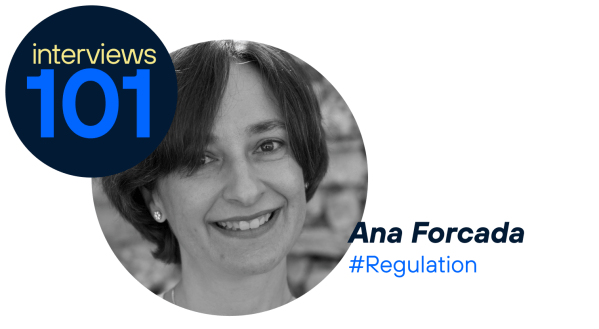RELATED POSTS
Enrique Medina Malo is Chief Policy Officer at Telefónica. Until 2006, he served as State Lawyer for the Spanish State Administration, Ministry of Science and Technology, Ministry of Industry and Energy and the High Court of Cataluña. From 2002 to 2004 he was appointed General Director for Legislation (Secretario General Técnico) of the Ministry of Science & Technology. He has also been Chief Legal Officer of the Spanish Broadcasting Corporation RTVE (2004-2006). Digital Future Society, the global think tank with the mission of understanding and engaging with the legal and ethical challenges and opportunities of digital transformation, talked to Enrique about the digital divide and what the private sector is doing to tackle the issue.

Bridging the digital divide is more complex than providing internet connectivity. Once access is provided, what is the biggest challenge low income groups face?
Finding new ways of providing better infrastructure to increase access to services is not enough unless people can see the benefits of using them. Even in well-connected areas, there are significant gender, age, income and education gaps in terms of Internet uptake. There are two key levers to solve this lack of interest:
- Development of digital skills. Lack of basic digital skills to access the Internet and use devices, and also of more advanced skills to be able to benefit from all possibilities opened up by being connected, are a key barrier for the use of Internet in lower income groups.
- Development of locally relevant content and services. One of the reasons people do not connect to the Internet is that there might not be relevant services or content available in local languages. Also, the implementation of an e-Government strategy by digitizing public services provided by administrations serves as a great incentive for digital adoption.
Affordability is often viewed and discussed as a relevant reason why people do not use the Internet. Obviously, people need to be able to pay for connectivity, so price levels do matter. Nevertheless, we do not see connectivity prices to be an issue in Latin America where we have Telefónica operations. As the Alliance for an Affordable Internet (A4AI) research shows, in most of the Latin American countries prices have significantly fallen over the last few years and today are well within the threshold for affordability as defined by A4AI and the United Nations. In Chile, Brazil, Argentina, Colombia and Mexico 1GB of data for Internet access is priced at 2% or less of monthly average income, making it affordable for the vast majority of people living in these countries.
It should also be noted that there are more, equally important, issues when we speak about affordability or barriers to usage of Internet: for example, the cost of the associated equipment and devices required to run digital applications and services. Computers, tablets, smartphones and the power supply required to run them need to be fairly priced and available so that people can take advantage of the connectivity available to them.
Flexible offers adapted to low-income households could be one solution. What other strategies is the private sector implementing to reduce the digital divide?
Telefónica, through its “Internet para Todos” project, has been working over the past two years to develop a completely new and innovative approach to connect the unconnected.
Most of the existing telecommunication and broadband business models were designed to provide connectivity in densely, highly populated urban areas. The huge fixed costs of network deployment turn into a heavy load for companies, so deployment is too expensive for rural areas, where demand is scarce and incomes lower. To address this challenge, we need to innovate in these three areas:
- Creating a new technology ecosystem to bring down the cost of deploying and running a mobile network in areas with lower population density and lower expected usage and consumption rations.
- Setting up a new open business model, which opens the network to all operators, extending services to low-density areas using just one infrastructure.
- Innovating the operational model, engaging local communities and entrepreneurs, as well as telecoms, digital leaders, investors, international organizations and development banks to finance and co-build this infrastructure together.
The result of these innovations has been Internet Para Todos (IpT) Peru, a new open rural wholesale mobile infrastructure provider we have launched together with Facebook, CAF and BID Invest. IpT is a private company resulting from a public-private partnership that aspires to become sustainable and profitable.
Internet Para Todos has already connected 1 million people in 4000 villages and towns in rural areas in Peru. IpT objective and mission is to solve the connectivity divide of the whole country. The social impact of bringing connectivity to 6 million people in Peru is obviously huge, but just imagine the impact if we achieve to bridge the connectivity divide across all of Latin America.
There isn’t much incentive for carriers to go into low-income areas. How can telcos balance business concerns with the public interest?
Actually, we see it differently. We see no conflict of interest between public administrations, the public interest and Telefónica. In fact, our interests are very much aligned: we all want to bring connectivity to all, full stop. So we agree on the objective, and the only issue is to find a win-win for all to achieve that shared, common objective.
The solution comes from innovating technology, the deployment model as well as the business model, to make connecting all a profitable and thus sustainable business model.
As we have seen in the initial steps of our Internet para Todos Peru project, there is untapped demand in rural and remote areas. Thanks to using AI and data analytics we were able to precisely locate this demand and thus were able to deploy the networks much more efficiently.
Obviously, Governments also have to do their part and help us to achieve this goal. Peru had a specific regulatory regime for a rural network operator provider that provided the right regulatory framework to launch our project. We are sure that when the right policies are in place, partnerships such as Internet Para Todos Peru can solve most of the connectivity divide without even recurring to public funds or subsidies.
 These past years we’ve experienced a rapid adoption of 4G and yet low-income and rural communities have no or low quality access. How can private work with public sector to reach these markets?
These past years we’ve experienced a rapid adoption of 4G and yet low-income and rural communities have no or low quality access. How can private work with public sector to reach these markets?
Addressing the connectivity challenge is not an issue to be solved by a unique stakeholder, whether private or public. Telefónica is aware that in order to bridge the digital divide it needs cooperation and partnerships. IpT Peru counts Facebook, CAF and BID Invest as partners. This open partnership model allows expanding this initiative into other countries, with potentially also additional and new partners that may have interests in the specific regions addressed.
What are Telcos’ role in creating awareness of the impact of emerging technologies?
Telefónica has been a technology company for nearly 100 years now, giving us a lot of experience with emerging technologies and transformation. The digital revolution is helping people and organisations to progress in previously unimaginable ways. The promise of new technologies to improve lives is compelling. However, tech driven digitalisation today runs the risk of being regarded as an even more radical form of globalisation, being perceived by parts of the population in developed economies as a source of inequality and degradation of living standards.
Our goal is to achieve a sustainable digitalisation, which must be an inclusive process that ensures everyone has the opportunity to participate in a connected world. In order to do that we need to guide people and societies through the digital transformation of the next decade, making them aware of new possibilities but also minimizing the risks of leaving people behind. Technology should not make inequalities bigger but close the gap.
This means in the end that we need active engagement from business and public sector to manage the societal impacts of technology as we have, for example, learned to better manage the environmental impacts of industrialization over the last decades. For sustainable digitalization, active support by modernizing Public Policies and more responsibility from companies is needed.
With growing interest in deploying 5G networks, how can we ensure those who are unconnected don’t fall far behind?
5G will first reach industrial and business applications, and at a later stage to the wider public. We are still deploying 4G in unconnected areas. Our first goal should be getting everyone connected. Nevertheless, our approach to developing 4G in the unconnected areas, such as in IpT Perú, has changed in order to bring down the deployment and operational costs. This new model is future proof, and thus easy to be upgraded to 5G.
Some argue that current regulation stifles the innovation brought on by 5G’s faster and better service. What is at risk if Europe falls behind in the implementation of 5G networks?
5G is the basis of the digitized economy and Europe needs to be at its forefront if it wants to have a relevant role in the digital economy. We need Europe to lead again the digitisation process, and to become the cradle of the next generation of digital unicorns. We cannot let 5G be a missing opportunity enabling existing tech companies to further consolidate their position while new Asian leaders further expand into Europe.
To regain this leadership regulation is the most relevant lever. Outdated regulation is a significant barrier for innovation, therefore new approaches like sandboxes for 5G are needed to allow for experimentation and learning by the industry and customers.
This interview was originally published in Digital Society’s blog, available at: https://digitalfuturesociety.com/qanda/enrique-medina/










